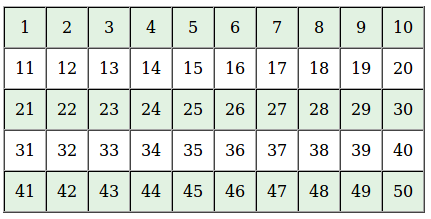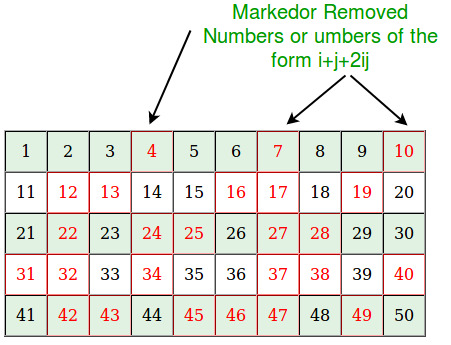给定数字n,请打印所有小于或等于n的素数。
例子:
Input: n = 10
Output: 2, 3, 5, 7
Input: n = 20
Output: 2, 3, 5, 7, 11, 13, 17, 19我们已经讨论了上述任务的Eratosthenes算法的Sieve。
以下是Sundaram算法的筛网。
printPrimes(n)
[Prints all prime numbers smaller than n]
1) In general Sieve of Sundaram, produces primes smaller than
(2*x + 2) for a number given number x. Since we want primes
smaller than n, we reduce n-1 to half. We call it nNew.
nNew = (n-1)/2;
For example, if n = 102, then nNew = 50.
if n = 103, then nNew = 51
2) Create an array marked[n] that is going
to be used to separate numbers of the form i+j+2ij from
others where 1 <= i <= j
3) Initialize all entries of marked[] as false.
4) // Mark all numbers of the form i + j + 2ij as true
// where 1 <= i <= j
Loop for i=1 to nNew
a) j = i;
b) Loop While (i + j + 2*i*j) 2, then print 2 as first prime.
6) Remaining primes are of the form 2i + 1 where i is
index of NOT marked numbers. So print 2i + 1 for all i
such that marked[i] is false. 下面是上述算法的实现:
C++
// C++ program to print primes smaller than n using
// Sieve of Sundaram.
#include
using namespace std;
// Prints all prime numbers smaller
int SieveOfSundaram(int n)
{
// In general Sieve of Sundaram, produces primes smaller
// than (2*x + 2) for a number given number x.
// Since we want primes smaller than n, we reduce n to half
int nNew = (n-1)/2;
// This array is used to separate numbers of the form i+j+2ij
// from others where 1 <= i <= j
bool marked[nNew + 1];
// Initialize all elements as not marked
memset(marked, false, sizeof(marked));
// Main logic of Sundaram. Mark all numbers of the
// form i + j + 2ij as true where 1 <= i <= j
for (int i=1; i<=nNew; i++)
for (int j=i; (i + j + 2*i*j) <= nNew; j++)
marked[i + j + 2*i*j] = true;
// Since 2 is a prime number
if (n > 2)
cout << 2 << " ";
// Print other primes. Remaining primes are of the form
// 2*i + 1 such that marked[i] is false.
for (int i=1; i<=nNew; i++)
if (marked[i] == false)
cout << 2*i + 1 << " ";
}
// Driver program to test above
int main(void)
{
int n = 20;
SieveOfSundaram(n);
return 0;
} Java
// Java program to print primes smaller
// than n using Sieve of Sundaram.
import java.util.Arrays;
class GFG {
// Prints all prime numbers smaller
static int SieveOfSundaram(int n) {
// In general Sieve of Sundaram, produces
// primes smaller than (2*x + 2) for a number
// given number x. Since we want primes
// smaller than n, we reduce n to half
int nNew = (n - 1) / 2;
// This array is used to separate numbers of the
// form i+j+2ij from others where 1 <= i <= j
boolean marked[] = new boolean[nNew + 1];
// Initialize all elements as not marked
Arrays.fill(marked, false);
// Main logic of Sundaram. Mark all numbers of the
// form i + j + 2ij as true where 1 <= i <= j
for (int i = 1; i <= nNew; i++)
for (int j = i; (i + j + 2 * i * j) <= nNew; j++)
marked[i + j + 2 * i * j] = true;
// Since 2 is a prime number
if (n > 2)
System.out.print(2 + " ");
// Print other primes. Remaining primes are of
// the form 2*i + 1 such that marked[i] is false.
for (int i = 1; i <= nNew; i++)
if (marked[i] == false)
System.out.print(2 * i + 1 + " ");
return -1;
}
// Driver code
public static void main(String[] args) {
int n = 20;
SieveOfSundaram(n);
}
}
// This code is contributed by Anant Agarwal.Python3
# Python3 program to print
# primes smaller than n using
# Sieve of Sundaram.
# Prints all prime numbers smaller
def SieveOfSundaram(n):
# In general Sieve of Sundaram,
# produces primes smaller
# than (2*x + 2) for a number
# given number x. Since we want
# primes smaller than n, we
# reduce n to half
nNew = int((n - 1) / 2);
# This array is used to separate
# numbers of the form i+j+2ij
# from others where 1 <= i <= j
# Initialize all elements as not marked
marked = [0] * (nNew + 1);
# Main logic of Sundaram. Mark all
# numbers of the form i + j + 2ij
# as true where 1 <= i <= j
for i in range(1, nNew + 1):
j = i;
while((i + j + 2 * i * j) <= nNew):
marked[i + j + 2 * i * j] = 1;
j += 1;
# Since 2 is a prime number
if (n > 2):
print(2, end = " ");
# Print other primes. Remaining
# primes are of the form 2*i + 1
# such that marked[i] is false.
for i in range(1, nNew + 1):
if (marked[i] == 0):
print((2 * i + 1), end = " ");
# Driver Code
n = 20;
SieveOfSundaram(n);
# This code is contributed by mitsC#
// C# program to print primes smaller
// than n using Sieve of Sundaram.
using System;
class GFG {
// Prints all prime numbers smaller
static int SieveOfSundaram(int n)
{
// In general Sieve of Sundaram, produces
// primes smaller than (2*x + 2) for a number
// given number x. Since we want primes
// smaller than n, we reduce n to half
int nNew = (n - 1) / 2;
// This array is used to separate
// numbers of the form i+j+2ij from
// others where 1 <= i <= j
bool []marked = new bool[nNew + 1];
// Initialize all elements as not marked
for (int i=0;i 2)
Console.Write(2 + " ");
// Print other primes.
// Remaining primes are of
// the form 2*i + 1 such
// that marked[i] is false.
for (int i = 1; i <= nNew; i++)
if (marked[i] == false)
Console.Write(2 * i + 1 + " ");
return -1;
}
// Driver code
public static void Main()
{
int n = 20;
SieveOfSundaram(n);
}
}
// This code is contributed by nitin mittal PHP
2)
echo "2 ";
// Print other primes. Remaining
// primes are of the form 2*i + 1
// such that marked[i] is false.
for ($i = 1; $i <= $nNew; $i++)
if ($marked[$i] == false)
echo (2 * $i + 1) . " ";
}
// Driver Code
$n = 20;
SieveOfSundaram($n);
// This code is contributed by mits
?>Javascript
2 3 5 7 11 13 17 19插图:
下图中的所有红色条目均为标记条目。对于每个其余(或黑色)条目x,数字2x + 1为质数。
让我们看看它在n = 102时如何工作,我们将得到(n-1)/ 2的筛子,如下所示:

标记所有可以表示为i + j + 2ij的数字

现在,对于列表中所有未标记的数字,找到2x + 1,这将是质数:
像2 * 1 + 1 = 3
2 * 3 + 1 = 7
2 * 5 + 1 = 11
2 * 6 + 1 = 13
2 * 8 + 1 = 17,依此类推。
这是如何运作的?
当我们产生最终输出时,我们会产生2x + 1形式的所有整数(即,它们是奇数),除了2是分开处理的。
Let q be an integer of the form 2x + 1.
q is excluded if and only if x is of the
form i + j + 2ij. That means,
q = 2(i + j + 2ij) + 1
= (2i + 1)(2j + 1)
So, an odd integer is excluded from the final list if
and only if it has a factorization of the form (2i + 1)(2j + 1)
which is to say, if it has a non-trivial odd factor.
Source: Wiki